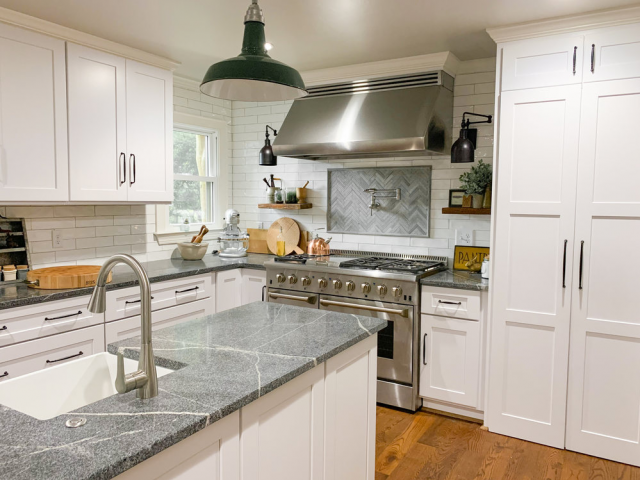Range hoods provide an attractive kitchen paradox. It is amongst the best features in a kitchen, and a high-quality range hood might be unnoticeable. However, its purpose is to keep your home kitchen’s air quality and cleanliness. The best quality Range hoods will filter out any pollutants or unwanted smells generated during cooking.
These are why you need the best Range hoods to keep your kitchen clean and hygienic. We will recommend some of the best range hoods in this article to make better decisions. You will also get some tips on what to keep in mind while choosing the range hood for your kitchen.
List of the best Range Hoods
- Viking a 36-Inch Wall Mount Convertible Chimney Range Hood
- Hauslane a 30-Inch Ducted Stainless Steel Under Cabinet Range Hood
- Cavaliere 30-Inch Convertible Wall Mount Range Hood
- Quietest: Broan-NuTone 30-Inch Convertible Undercabinet Range Hood
- Broan-NuTone, a 30-Inch Ductless Stainless Steel/Black Under Cabinet Range Hood
- ZLINE 36-Inch Wall Mount Range Hood
- Cosmo 30-Inch Island Mount Range Hood
How to Select the Right best Range Hood for You
There are a lot of range hoods out there that are vying for your attention. Continue reading to grasp the elements better to look for that will help you narrow down your options and make a final decision.
Kitchen Dimensions and Layout
Because some kitchen layouts require a specific range hood, it’s crucial to know which category yours fits into before shopping for one. A wall-mounted range hood is ideal for open wall space above your stove. Stick with an under-cabinet and microwave range hood if you have cabinetry or a microwave. Only island range hoods (if ductwork can be installed in the ceiling) or downdraft range hoods will operate in kitchens with islands (if you have to put ductwork on the floor).
Similarly, the variety of range hoods you can buy may be limited based on the size of your kitchen or home. For example, in a tiny kitchen or apartment, a wall-mounted range hood may be difficult to fit, whereas a microwave or under-cabinet range hood will not suffice if you have a huge kitchen that requires plenty of air.
Ducted vs. Ductless: What’s the Difference?
The air treated by the range hood is vented somewhere (usually outside) via a duct system in a ducted range hood. Depending on your home, the ducting might be installed in the ceiling, walls, or floor. After filtration, a ductless range hood, also known as a recirculation or recirculating system, will return air to the kitchen. Some range hood types work with ducted and ductless systems (and can be converted between the two), while others only come in one kind.
While a ducted system is often more efficient and powerful than a ductless system, your final decision will be based solely on compatibility with your kitchen, home, or apartment and your specific demands.
Cooking Techniques
It is critical to select a range hood compatible with your cooking style and kitchen layout. When making this option, consider three primary factors: airflow in CFM, number of fan speeds, and noise level. The digit of cubic feet per minute (CFM) shows how much air the unit is processing at any given time. Your range hood will ventilate—the greater the number, the faster your kitchen. To match, fans should have at least two speed options (high and low) and a noise level or range.
If you like to be a professional chef and do a lot of heavy and intensive cooking regularly, you’ll need a range hood with a lot of CFM (at least three fan speeds) and a noise level you can stand for long periods. If you cook modest meals once or twice a day—or a few times a week—you can get away with a lower CFM and fewer fan speeds (though you should always make sure you can tolerate the bluster level of the fans).
Additional Features
Other things are exhaust timings, auto shut-off, control panel type, filter types, and lighting setup when selecting a range hood. While there is no one-size-fits-all solution, some characteristics may be more useful than others. If you wish to wash your filters in the dishwasher, ensure they are dishwasher safe. You’ll probably like an auto shut-off or exhaust timer feature if you leave the fan running after cooking to clear out any residual scents in your kitchen. Fortunately, given the wide choice of goods and models available, finding a range hood that meets your demands shouldn’t be too difficult.
There Are Five Different Types Of Range Hoods
Range Hoods with a Wall Mount

If no existing cabinetry poses an issue, a wall-mounted range hood can be fitted over a cooking surface (if some do, take a look at under-cabinet range hoods instead). As the name implies, the unit is installed against the wall and is usually ducted, though ductless variants are available. Wall-mounted range hoods, which come in various forms, colors, and sizes, are sometimes known as chimney hoods because their general design and ventilation system is comparable to that of a chimney.
Range Hoods for Under-Cabinet Use

Range hoods fitted beneath existing cabinets are known as under-cabinet range hoods. They are open in both ducted and ductless designs (in the case of the former, ductwork is generally routed through the closest wall or ceiling before getting the exhaust vent). Under-cabinet range hoods are often less and lower in weight than a full-size range hood. These are an ideal option for everyday cooks in apartments and homes with limited cabinet space.
Range Hoods on the Islands
Range hoods for the island are built into the ceiling and dangle directly above the cooking area. Because it must catch all of the air rising and spreading from the island into the room, the ductwork generally runs through the ceiling and has greater airflow rates. There are various designs and styles to select from, but island range hoods are often more costly and difficult to install than other types of range hoods.
They also have further requirements, such as having high enough ceilings to provide appropriate clearance for the unit. When done correctly, an island range hood may become more than simply a functional addition to your kitchen: it can also be a gorgeous focal point.
Range Hoods with Downdraft Vents
Downdraft range hoods are sleek and attractive to any kitchen, especially since they are frequently installed as pop-up vent units covered when not in use. These work in theory by sending any smoke or air downward, where it is evacuated out of your home via a ductwork system on your floor. Downdraft range hoods lack power and are a small, efficient method to clear pollutants such as smoke from your kitchen, while they are convenient for island stove tops where it is not practicable to install an island range hood.
Range Hoods for Microwaves
If your microwave is mounted above your stovetop, you probably have a microwave range hood, which means the fan is incorporated into the microwave’s underside. This range hood is convenient, less expensive to install than a separate range hood (because you normally only buy one appliance), and takes up less room. After being filtered, air from a microwave range hood unit is vented back into your home via a recirculating, ductless ventilation system. Microwave range hoods, while popular, are not as powerful or effective at filtering air as ducted range hoods.
Methodology
Our team reviewed third-party data on over 80 products to determine the best range hood ranking. A variety of metrics are used to calculate each product’s star rating, including:
- Average Cost (20 percent )
- Feedback from Customers (20 percent )
- Number of Retailers in the Area (15 percent )
- Guarantee (15 percent )
- Timers for exhaustion (10 percent )
- Variable Fan Speeds (10 percent )
- Control Panel with Touch Screen (10 percent )
Most Frequently Asked Questions (FAQs)
How do you i choose the size of a range hood?
To determine the correct range hood size, first, determine the size of your cooktop. Any smoke, oil, or odors produced will be most effectively sucked up, filtered range hood fans, and ventilated if your range hood is the same width as your cooking surface. The most typical range hood widths are 30″, 36″, 42″, and 48″, and your cooktop will most likely fit into one of those site’s range hoods on sale.
The size of the space available above and surrounding your cooktop and the depth of your cooking surface, and the type of range hood you intend to purchase will determine the height and depth of your range hood. Be careful to account for product clearance, as certain range hoods require a certain amount of space above the stove to install a range hood extinguishing system.
What’s the best way to clean a range hood?
You can clean your range hood using various cleaning solutions if it’s dirty or oily. A normal hot water and dish soap solution will remove part of the grime after a gently dusting. Use a vinegar solution or a degreasing product to eliminate tenacious filth.
Brushes with sharp bristles should be avoided since they can harm the surface of your range hood. You can either put the filters in the dishwasher (if safe) or wash them by hand with soap. Baking soda can also be used to break away the thickest oil deposits. If you prefer store-bought cleaners and degreasers, seek eco-friendly all-purpose or multi-surface cleaners and degreasers range hood filters by size.
What CFM should a range hood have?
The ideal CFM for a range hood will be determined by your kitchen layout and several other criteria, such as the quantity of ventilation required and the amount of noise you can bear. The higher the CFM, which measures airflow through the range hood in cubic feet per minute, the more powerful the range hood. While you’ll need to study to discover the appropriate CFM for your kitchen, a minimum of 100 CFM of airflow for 12 inches of cooktop width is recommended for the casual cook. This will provide you with a range hood that can handle your everyday cooking and inexpensive range hoods.
Is it feasible to vent a range hood via the wall?
You can vent your range hood via a wall with a compatible ductwork system range hood store. Though venting through an outside wall is more frequent, you may also vent your range hood through an inside wall with the right precautions. Ensure you’re not venting into an area where polluted air can accumulate. Some range hoods, such as island range hoods, must be vented through the ceiling, while downdraft range hoods must be vented via the floor, according to their construction.













